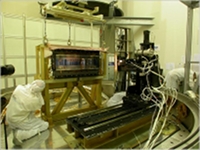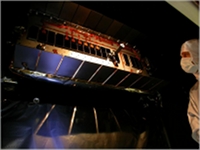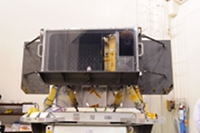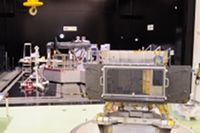Gaia's 'eyes' and 'brain' pass tests
23 November 2010
Another milestone in the development of ESA's Gaia spacecraft has been passed with the successful conclusion of two parallel test programmes during October. These tests demonstrated that Gaia's focal plane assembly (FPA) - the 'eyes' of the spacecraft - is structurally and functionally fit for flight.Gaia has been designed to map the entire sky with unprecedented accuracy. Over its 5-year mission, it will repeatedly observe 1 thousand million stars in order to pinpoint their positions and brightness. This will be made possible by using two medium-sized telescopes to direct starlight through a focal plane assembly fitted with large CCD detectors.
|
The engineering model of the Gaia focal plane assembly. | |
In order to ensure that this key part of the spacecraft's optical system is capable of functioning properly, an engineering model of the FPA underwent a series of electrical and functional tests in a vacuum chamber at the premises of Astrium in Toulouse. These involved passing an optical image of a star pattern across one row of the focal plane. As each stellar image passed across each of the 16 CCDs, it was detected, confirmed and tracked as a star by the video processing unit (VPU) – the 'brain' of Gaia. The VPU created small 'windows' around each star which 'remembered' its location in the sky image.
The windowing of the confirmed stars is a key aspect of Gaia's operations since it enables the data to be automatically discarded from any parts of the sky image that are lacking recognised stars. Without this intelligent software processing, Gaia would be swamped by the vast amount of data it records and sends back to Earth.
"We need to use windowing because of the telemetry limit on the spacecraft," explained Timo Prusti, the Gaia Project Scientist. "Only so much data can be stored on board and sent back to Earth, even at a rate of 4-8 Megabits per second. During most of the mission, there will only be 8 hours of contact time with the ground stations in which to download 24 hours of data, although this contact time will be doubled when Gaia is observing the mass of stars across the galactic plane."
"The windowing approach allows Gaia to observe a thousand million stars and to transmit the recorded information without swamping the telemetry download capability. The successful tests of the FPA and the video processing system, which selects and tracks the stars across the focal plane, were a major step in the development of the Gaia flight model," he added.
A structural model (SM) of the FPA, which comprised all of the flight model structural parts, also completed a separate series of mechanical tests at the Toulouse premises of INTESPACE. By placing the SM on a shaker, engineers confirmed the ability of the FPA to survive the stresses of launch.
|
The structural model of the Gaia focal plane assembly. Credit: Astrium | |
"Having tested and validated both the electronic and the mechanical sides of the FPA, we are now ready to start assembly of the flight model," said Philippe Gare, the Gaia Payload Module Manager.
"The completion of the functional and qualification tests on the focal plane assembly engineering and structural models was a fundamental step in the development of the Gaia detection system," said Giuseppe Sarri, the Gaia Project Manager. "The tests on the engineering model demonstrated that the detection chain works in the environmental conditions expected in space and that the performances are compliant with the requirements, therefore giving confidence that the Gaia scientific objectives will be met. The mechanical tests confirmed the robustness of the overall focal plane to sustain the launch loads. Last but not least, the assembly of both models validated the very complex and delicate integration procedures required to build the flight model."
Contacts:
Philippe Gare
Gaia Payload Module Manager
Directorate of Science and Robotic Exploration
ESA, The Netherlands
Email: Philippe.Gare esa.int
esa.int
Phone: +31 71 5655671
Gaia Project Manager
Directorate of Science and Robotic Exploration
ESA, The Netherlands
Email: giuseppe.sarri
 esa.int
esa.int Phone: +31 71 5654966 Timo Prusti
Gaia Project Scientist
Directorate of Science and Robotic Exploration
ESA, The Netherlands
Email: tprusti
 rssd.esa.int
rssd.esa.int Phone: +31 71 5654794










